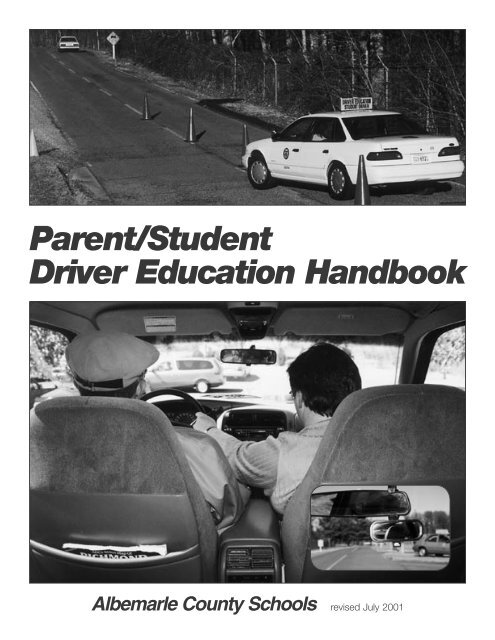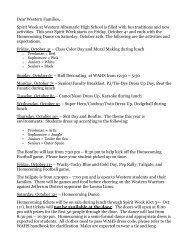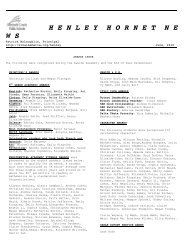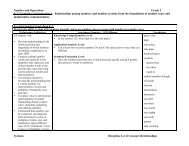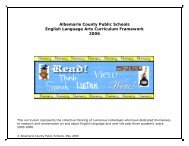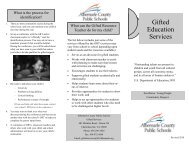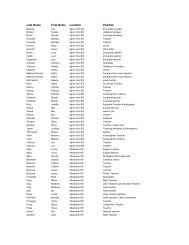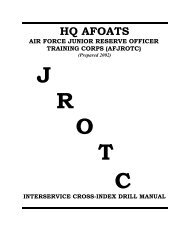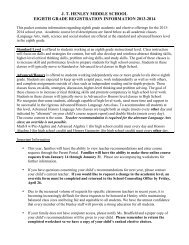Driver's Ed Manual - Albemarle County Public Schools
Driver's Ed Manual - Albemarle County Public Schools
Driver's Ed Manual - Albemarle County Public Schools
You also want an ePaper? Increase the reach of your titles
YUMPU automatically turns print PDFs into web optimized ePapers that Google loves.
Parent/Student<br />
Driver <strong>Ed</strong>ucation Handbook<br />
<strong>Albemarle</strong> <strong>County</strong> <strong>Schools</strong> revised July 2001
Written and compiled by Richard Wharam, July 2000<br />
Graphic Design by Birch Studio Graphics<br />
The assistance of the Automobile Association of America is gratefully acknowledged.
Table of Contents<br />
Introduction . . . . . . . . . . . . . . . . . . . . . . . . . . . . . . . . . . . . 2<br />
Requirements for Learner’s Permit . . . . . . . . . . . . . . . . . . 2<br />
Requirements for Permanent License . . . . . . . . . . . . . . . . 2<br />
The Parent as Teacher . . . . . . . . . . . . . . . . . . . . . . . . . . . . 3<br />
Lesson 1: Starting With Good Habits . . . . . . . . . . . . . . . . 3<br />
Lesson 2: Subdivision Driving . . . . . . . . . . . . . . . . . . . . . 4<br />
Lesson 3: Rural Road Driving . . . . . . . . . . . . . . . . . . . . . 5<br />
Lesson 4: Routes 29 and 250—Multi-lane Congestion . . 5<br />
Lesson 5: Interstate Driving . . . . . . . . . . . . . . . . . . . . . . . 6<br />
Driving Tips . . . . . . . . . . . . . . . . . . . . . . . . . . . . . . . . . . . 6<br />
Driving Logs . . . . . . . . . . . . . . . . . . . . . . . . . . . . . . . . 10-12<br />
<strong>Albemarle</strong> <strong>County</strong> Driver <strong>Ed</strong>ucation Program . . . . . . . . 13<br />
Website Information . . . . . . . . . . . . . . . . . . . . . . . . . . . . 13<br />
Effective July 1, 2001:<br />
Students possessing a learner’s permit prior to July 1, but not turning 16 years old until after<br />
July 1, 2001, will be eligible for a temporary license when:<br />
• The student is at least 16 years old and has held a learner’s permit for at least six<br />
months.<br />
• The student successfully completes a state approved driver education program.<br />
• The parents have signed the PPF-01 Permission Form certifying their child is properly<br />
insured, and has driven a motor vehicle for 40 hours—at least 10 of which<br />
were after sunset.<br />
• The student submits a driving log of 40 hours.<br />
Students possessing a Learner’s Permit:<br />
• are restricted to one non-family member teenage passenger<br />
• have a midnight to 4am curfew<br />
• must log driving experiences: 30 hours of daylight driving and 10 hours of driving<br />
between sunset and midnight<br />
<strong>Albemarle</strong> <strong>County</strong> High <strong>Schools</strong>
Parents may want to practice steering with the left hand from the passenger seat.<br />
Introduction<br />
The Virginia General Assembly frequently enacts legislation to address teenage driving issues. Nationally teenagers<br />
account for 4% of all drivers, yet they have 13% of the crashes. Forty per cent of 16 year olds either<br />
violate a traffic law or are involved in a crash their first year of driving. First year driver behavior and skills<br />
haven’t changed over the years, but the driving environment has changed. In 1962 there were 92 million drivers in<br />
the United States. Today there are 181 million drivers! The number of roads has not doubled in the last 39 years.<br />
However, many of them have been widened to four or more lanes. First year drivers today must learn in a more<br />
congested environment than we ever imagined.<br />
This guide has been prepared to give the parent some helpful suggestions in planning in-car training for their teenage<br />
driver. Experts recommend 50 hours of supervised driving practice before students are allowed to drive alone.<br />
This step is so important that we have included a driving log on page 10 for your convenience. Keep track of the<br />
time spent on each lesson. Effective July 1, 2001 this is now required by Virginia law.<br />
The <strong>Albemarle</strong> <strong>County</strong> Driver <strong>Ed</strong>ucation Program schedules students for 15 to 20 hours of driving experiences<br />
on the range and on the highway. At the end of the training course the student will be given a comprehensive road<br />
test of 25 minutes. The assessment includes multi-lane traffic, lane changes, negotiating intersections, yielding<br />
right of way, and parking in shopping centers. Approximately 80% of students are successful on the first attempt.<br />
Instructors are not trying to be punitive, but want these students to be safe drivers. Students must wait two weeks<br />
before requesting another road test.<br />
Even though the student passed the road skill test, they still are lacking in experience necessary to handle unusual<br />
driving situations. Therefore; parents need to give their students as much supervised driving time as possible.<br />
Consider one year to be the minimum learning time. The parent is the ultimate judge of the student’s ability.<br />
> DMV Requirements for Learners Permit<br />
• 15 years, six months of age<br />
• birth certificate<br />
• social security card<br />
• pass knowledge and vision tests<br />
• parent signature<br />
Note: All requirements are in effect as of July 1, 2001.<br />
... and for a Permanent License<br />
• 16 years, 3 months of age or older<br />
• possess learner’s permit for 9 months or longer<br />
• completed 36 hour Driver’s <strong>Ed</strong>ucation classroom<br />
• completed min.14 hours of in-car driver education<br />
• parental permission<br />
• submit the 40-hour driving log<br />
Note: Parents are now required to sign the driver license. The license states that parents can telephone the DMV<br />
and have the license revoked prior to age 18. The license will be revoked for a minimum of 6 months.<br />
<strong>Albemarle</strong> <strong>County</strong> High <strong>Schools</strong><br />
2
The Parent As Teacher<br />
> Getting Started<br />
Remember 14-15 years ago when your student was an<br />
infant and just learning to walk? That first step was a<br />
big event in the life of the family. Now your child is<br />
ready to take another step. As a parent you’ll use the<br />
same technique of instruction to teach the operation of<br />
a vehicle. One step at a time! The first step should be<br />
simple and then build upon that success, not expecting<br />
too much the first day. Patience means you expect mistakes<br />
and will allow for them. Learning this coordination<br />
skill is the same as learning a sport like basketball.<br />
Did you make the basket on the first throw? Sometimes<br />
we learn more from our failures than our successes. We<br />
learn to drive best in small daily segments of 10 to 15<br />
minute learning experiences. Trying to accomplish too<br />
much one day per week can be frustrating for both student<br />
and parent. Try these lesson suggestions.<br />
> Establishing a Comfort Level<br />
Before you have the first lesson with your student driver,<br />
plan for both parents to venture out to a parking lot<br />
and practice several maneuvers.<br />
1<br />
LESSON<br />
ONE<br />
Starting with Good Habits<br />
> Location<br />
We recommend a large parking lot free of obstacles. Your<br />
public school parking lot after school hours or on weekends<br />
is one possibility. Be sure your student has their<br />
learner’s permit and that you are in the car at all times.<br />
The first driving experience should focus on starting,<br />
steering and stopping a car within two points on the lot.<br />
Driving ranges use two cones spaced 33 yards apart.<br />
You could substitute milk containers, or lines on the<br />
parking lot. A distance of 33 to 50 yards is all that is<br />
required.<br />
> Outside Checks<br />
1. Look for objects around the car and in the path you<br />
intend to travel.<br />
2. Glance at tires for proper inflation.<br />
3. Verify that windows, headlights and taillights are<br />
clean.<br />
4. Glance under hood for leaking fluids.<br />
First, each parent should practice on a parking lot steering<br />
the car with the left hand from the passenger seat.<br />
New drivers are prone to hug the right edge of the road.<br />
They will grow out of it. Until they do, the parent can<br />
gently steer the car back to the left.<br />
Second, if you have a car with the parking brake<br />
between the seats, practice stopping the car by depressing<br />
the release button and slowing the car by raising<br />
the parking brake. Cars with between the seat parking<br />
brakes make ideal training cars.<br />
Third, parents may want to invest<br />
$6 in a baby rear view mirror<br />
attachment. When sitting in the<br />
passenger seat, you will want<br />
to know who’s behind you. This<br />
handy mirror is available in the<br />
baby section of the Giant grocery<br />
store.<br />
Fourth, parents may want to practice shifting the transmission<br />
into neutral from the passenger seat. Should a<br />
student panic, you can regain control by placing the car<br />
in neutral. Be careful not to shift into reverse!<br />
* The DMV and the <strong>Albemarle</strong> <strong>County</strong> School Board<br />
require the submission of a log of driving experiences<br />
before the temporary license can be issued after passing<br />
the road test. Students must have a minimum of 30<br />
hours of daylight driving and 10 hours of night driving.<br />
Use the log on pages 10 through 12.<br />
> Inside Checks<br />
1. Lock all doors<br />
2. Verify there are no articles in the car that will<br />
block your view or will fly around if you stop<br />
quickly.<br />
3. Put key in ignition switch and explain the positions<br />
4. Demonstrate how to sit with your back firmly<br />
against the seat with your shoulders even with or<br />
above the steering wheel. The driver should have<br />
10 inches of space between themselves and the<br />
steering wheel if you have an airbag. Adjust the<br />
seat if necessary to comfortably reach brake and<br />
accelerator pedals.<br />
5. Once in position lock the seatbelts.<br />
6. Adjust mirrors: side and rearview.<br />
7. Adjust head restraint to back of head<br />
3 <strong>Albemarle</strong> <strong>County</strong> High <strong>Schools</strong>
Starting the Engine<br />
1. Make sure parking brake is engaged<br />
2. Verify the transmission selector is in PARK or<br />
NEUTRAL and clutch engaged for manual transmission.<br />
3. Right foot depresses brake pedal.<br />
4. Turn the ignition switch to “on” position. Draw<br />
attention to the warning lights on the dashboard<br />
and their meaning. Continue turning key forward<br />
to start the engine and release as soon as engine<br />
starts.<br />
5. With engine running. Check the gauges. Check<br />
the fuel supply.<br />
> Steering Technique<br />
With the development of the airbag, driver education<br />
teachers are now required to instruct students in<br />
the “push-pull” method of steering. The right hand is<br />
placed at the four o’clock position and the left hand is<br />
placed at the eight o’clock position. The right-hand<br />
moves between the five and two o’clock position and<br />
the left-hand moves between the seven and 10 o’clock<br />
position. This technique of push-pull steering or shuffle<br />
steering is the safest method if the air bag deploys.<br />
Hand over hand steering or nine and three steering can<br />
result in injury in air bag deployment. Parents should<br />
not despair if they are unable to demonstrate this new<br />
method. Students will learn the new method on the<br />
range and then come home and teach mom and dad!<br />
* The DMV and the <strong>Albemarle</strong> <strong>County</strong> School Board<br />
require the submission of a log of driving experiences<br />
before the temporary license can be issued after passing<br />
the road test. Students must have a minimum of 30<br />
hours of daylight driving and 10 hours of night driving.<br />
Use the log on pages 10 through 12.<br />
> Putting the Car in Motion<br />
The parent should demonstrate the following steps<br />
before the student attempts to drive.<br />
1. Press down on the brake pedal.<br />
2. Move the selector to drive<br />
3. Release the parking brake while the foot is still on<br />
the brake pedal<br />
4. When the way is clear, remove the foot from the<br />
brake pedal and allow the car to roll from point A<br />
to point B. It is not necessary for this first experience<br />
to use the accelerator pedal. Just allow the<br />
engine idle speed to carry the car forward at 5 mph.<br />
Instruct the student to gently squeeze the brake<br />
pedal to stop.<br />
5. Now it is time to reverse course. Instruct the student<br />
to place the transmission selector in reverse.<br />
Place the left hand at the twelve o’clock position,<br />
right hand on the seat back, and look over the right<br />
shoulder while backing. Again it is not necessary<br />
to use the accelerator pedal.<br />
6. Repeat steps four and five until the student is competent<br />
7. Next, demonstrate how to drive the car in circles<br />
around the perimeter of the course. Allow the student<br />
to drive. Practice stopping the car at predetermined<br />
places.<br />
> Summary<br />
There is a lot to learn in the first lesson. Some students<br />
may need to repeat this lesson to be proficient.<br />
Mastery at each level is important before moving on to<br />
the next lesson.<br />
2<br />
LESSON<br />
TWO<br />
Subdivision Driving<br />
The student is now ready for subdivision driving. Pick<br />
a large subdivision and a time when the pedestrian<br />
and vehicular traffic will not be a major distraction for<br />
your student. Practice riding through the subdivision<br />
at speeds up to 25 mph making right and left turns.<br />
Instruct your student to come to a complete two second<br />
stop at Stop signs; look left, right, and left. It is<br />
critical that the parent model good driving practices.<br />
The student can easily pick up bad habits! At least two<br />
driving experiences in this environment are necessary<br />
before moving on to lesson three.<br />
* The DMV and the <strong>Albemarle</strong> <strong>County</strong> School Board<br />
require the submission of a log of driving experiences<br />
before the temporary license can be issued after passing<br />
the road test. Students must have a minimum of 30<br />
hours of daylight driving and 10 hours of night driving.<br />
Use the log on pages 10 through 12.<br />
<strong>Albemarle</strong> <strong>County</strong> High <strong>Schools</strong><br />
4
LESSON<br />
3 4<br />
THREE<br />
Rural Road Driving<br />
Pick a time when traffic is light; ie: Sunday morning<br />
between 7am and 9am or weekends between 2<br />
and 3pm. The parent should demonstrate the driving<br />
techniques he/she uses. As you drive, describe to the<br />
student where you are looking, mention the importance<br />
of looking ahead, steering to a target in the center of<br />
the lane, checking rear view mirrors and watching the<br />
speedometer.<br />
LESSON<br />
FOUR<br />
Route 29 & 250 Multi-lane<br />
Congestion<br />
> Lane Changes<br />
On Sunday mornings Route 29 has a low volume of<br />
traffic and presents a less threatening environment<br />
for your student to learn. Lane changes and checking<br />
blind spots are crucial for multi-lane driving. The steps<br />
for lane changes are: 1) check rear-view mirror, 2)<br />
check side view mirror, 3) signal, 4) head check behind<br />
door post to check blind spot.<br />
When the lane is clear move gradually into the desired<br />
lane.<br />
Target the center of the lane.<br />
Allow the student to drive at speeds up to 35 mph. In<br />
this session you’re interested in developing lane position,<br />
speed control, adjusting speed on curves and hills,<br />
developing a visual lead of 20 seconds, and a 3 second<br />
following distance.<br />
Students should spend the next five to 10 hours driving<br />
in the rural environment. On the second or third<br />
lesson allow the student to reach speeds of 45 mph.<br />
Eventually the student should graduate to larger rural<br />
roads such as Rt. 33 or Route 250 and drive at speeds<br />
of 55 mph.<br />
Sunday morning on Route 29.<br />
> Intersections<br />
As a driver approaches an intersection from a distance<br />
and sees a green light, we call that light a “stale green<br />
light”, because you don’t know when it may turn yellow.<br />
The DMV manual indicates drivers should stop<br />
on a solid yellow light if they have not entered the<br />
intersection. When stopping on a yellow light, check<br />
the rear view mirror before touching the brake pedal.<br />
A tailgating car may rear-end you if come to a quick<br />
stop on a yellow light. Come to a stop if you can safely<br />
do so. It takes practice to develop this skill of judging<br />
a safe stopping distance.<br />
> Right Turn on Red<br />
The right turn on red law dates back to the seventies.<br />
The law states that drivers may turn right on red after<br />
stop! The law does not permit right turn on red while<br />
rolling. The wheels must stop turning. Teenagers<br />
pick-up this bad habit from adults.<br />
> Safe Following Distance<br />
Most parents were taught the old method of allowing<br />
fifteen feet for every 10 mph of speed. Today we have<br />
a much simpler method. When the shadow from the<br />
car in front of you passes underneath a bridge or by an<br />
electric pole or sign post, start counting; one-thousand<br />
and one, one-thousand and two, and one-thousand and<br />
three. If you arrive under the bridge, or by the post or<br />
pole before one-thousand and three, you are following<br />
too close. Drop back and start counting again. Play<br />
5 <strong>Albemarle</strong> <strong>County</strong> High <strong>Schools</strong>
this game frequently until you can judge the proper distance<br />
without counting.<br />
5<br />
LESSON<br />
FIVE<br />
Interstate Driving<br />
On Sunday mornings between 7am and 9am the interstate<br />
highway traffic volume is low. Interstate driving<br />
requires the development of new skills: merging, lane<br />
changes, maintenance of speed and exiting. AAA<br />
recommends that merging vehicles on entrance ramps<br />
should be traveling at 60 to 65 mph at the merge point.<br />
Traveling at the highway speed requires less of a gap in<br />
traffic to merge. The steps for merging are: Rear view<br />
mirror check, side view mirror check, signal, and head<br />
check behind the door post. If the driver is following<br />
another car onto the interstate, the following distance<br />
should be 4 seconds and the driver must employ rapid<br />
eye movement between mirrors and the car in front.<br />
Emphasize the danger of slowing below the speed limit<br />
on an interstate highway. This is why cars do not slow<br />
down on the interstate preparing to exit. Enter the<br />
deceleration lane and then brake to slow down.<br />
> Driving Tips<br />
The following driving tips should be helpful to the parent<br />
and student. Review these often to promote safe<br />
driving.<br />
1. Driving with your low beam headlights on during<br />
the day decreases your chance of being involved in a<br />
fatal crash by 28%. Drivers with their headlights on<br />
can be seen from 4700 feet away as opposed to 2500<br />
feet without headlights. Drivers are less likely to pull<br />
out in front of you on those winding country roads.<br />
3. Maintain a 3-second following distance behind the<br />
vehicle in front of you. As the vehicle’s shadow in<br />
front of you passes an object, start counting: one-thousand<br />
and one, one-thousand and two, and one-thousand<br />
and three. If you arrive at the spot before one-thousand<br />
and three you are following too close.<br />
4. On multi-lane highways avoid driving in the left<br />
lane alongside other vehicles. Either slow down and<br />
get behind the other car in the right lane, or pass the<br />
vehicle and move to the right lane. Any time you are<br />
traveling alongside another vehicle you are in danger.<br />
5. Driver’s with airbags should position themselves<br />
at least 10 inches from the steering wheel. An airbag<br />
deploys in 1/5 of a second. You want to hit the airbag<br />
in a crash, not the airbag hitting you.<br />
6. Driver’s with airbags should use eight and four hand<br />
position on the steering wheel. This steering technique<br />
is called push-pull steering. The right hand moves<br />
between the two and five position and the left hand<br />
moves between the seven and ten position. This position<br />
is safer than the old ten and two, or nine and three<br />
position.<br />
7. Driving is a full time job. Pay attention. AAA<br />
research indicates that 37 % of drivers at any given<br />
moment are not paying attention! You can prove it<br />
the next time it rains. Thirty-seven percent of drivers<br />
won’t have their lights on with their wipers as the law<br />
requires.<br />
8. Remember the four steps of lane change procedure.<br />
1) check rear view mirror, 2) check side view mirror,<br />
3) give a signal, 4) perform a head check behind the<br />
door post, 5) move over to the next lane. Execute only<br />
one lane change at a time.<br />
2. Scan ahead of your vehicle 20 seconds or 1/3<br />
of a mile at 60 mph; or 1.5 to 2 city blocks in city<br />
driving. Such a habit will allow you to adjust speed<br />
or position before you happen upon threatening<br />
situations.<br />
<strong>Albemarle</strong> <strong>County</strong> High <strong>Schools</strong><br />
6
9. Never change lanes in an intersection. When turning<br />
into an intersection, occupy the nearest lane. For<br />
example, if you are turning left onto a divided 4 lane<br />
highway, occupy the left lane first, then execute a lane<br />
change procedure to the right lane.<br />
10. On interstate highways travel the posted speed.<br />
Slowing down on the interstate to exit, creates a hazard.<br />
Exit onto the deceleration lane and then brake. Observe<br />
the posted exit speed. Exit speed signs of 25 mph indicate<br />
a sharp curve in the exit ramp.<br />
Navigating Intersections.<br />
• Car 1 is turning right and should occupy lane S1 (the nearest land). Never change lanes in an intersection.<br />
If you want to be in lane S2, then occupy lane S1 and perform a lane change procedure to S2<br />
• Car 2 is making a left turn and should occupy land N4 (nearest lane). Do not change lanes in an<br />
intersection. If you want to be in lane N3, then occupy lane N4 and perform a lane change procedure<br />
to N3.<br />
• Car 1 wants to turn right on red after stopping. Car 7 has a green arrow and is turning left to occupy<br />
land S4. Car 1 must yield until car seven has completed his turn. A driver can not assume Car 7 will<br />
occupy lane S4. Remember, Car 1 has a red light and must yield the right of way.<br />
• Car 3 has a green left turn arrow and is attempting a U-turn to the south-bound lanes. Most likely<br />
Car 3 will occupy lane S1. Car 1, making a right turn on red, must yield the right of way to Car 3.<br />
• You are Car 5 traveling at 45 mph and the traffic signal turns yellow. Do you speed up to make it<br />
through the intersection as many drivers do? The DMV manual indicates that if you have not entered<br />
the intersection, you should come to a stop. With experience you will be able to judge your stopping<br />
distance at various speeds. Before your foot touches the brake, check the rear view mirror. If you<br />
slam on the brake with a tailgater behind you, you may have a car in the trunk.<br />
7 <strong>Albemarle</strong> <strong>County</strong> High <strong>Schools</strong>
11. Drivers should adjust speed at the top of an interstate<br />
entrance ramp. By traveling at the interstate speed<br />
at the merge point, drivers need less of a gap in traffic<br />
to merge. Attempting to merge on an interstate at 25 to<br />
35 mph creates a traffic hazard.<br />
12. When a traffic light turns yellow, come to a stop<br />
if you can safely do so. Check your rear view mirror<br />
before touching the brake to determine if a tailgater is<br />
too close to stop safely. A yellow light does not mean<br />
speed up to cross the intersection.<br />
13. Establish a 4 second stopping distance or escape<br />
path at 55 mph. It takes 4 seconds to stop a vehicle<br />
at 55 mph. If you are not looking ahead 4 seconds,<br />
you may not be able to react in time to an unexpected<br />
development.<br />
14. Remember the right of way rule? The driver on<br />
the left yields to the driver on the right. The right of<br />
way is a gift. Do not assume the other driver remembers<br />
the rule correctly or will yield to you. Drivers on<br />
minor roads must always yield to vehicles on major<br />
roads. Car Two is the first car to have right of way. Car<br />
One is next and Car Three is last.<br />
has the best Web site for crash worthiness. Type<br />
www.highwaysafety.org to determine how well your<br />
chosen vehicle withstands a 35 mph crash.<br />
17. Passing a vehicle on a two lane road is a dangerous<br />
maneuver. You must speed 10 miles per hour faster<br />
than the vehicle you are passing. If a vehicle in front<br />
of you is traveling at 50 mph, you will break the speed<br />
limit to pass the vehicle. Slow down, enjoy the drive.<br />
18. Driving is not a competitive sport. Aggressive<br />
driving involves speeding, tailgating, and lane changing<br />
without signals. Drivers with 3 traffic violations<br />
inside a year are 100% likely to be involved in a crash.<br />
Your insurance company will have to something to say<br />
about that.<br />
19. Look over your right shoulder when backing. If<br />
your neck won’t turn enough, try planting your left foot<br />
on the floor to push yourself up in the seat. Remember,<br />
backing is a slow maneuver.<br />
20. The speed limit in a city is 25 mph unless otherwise<br />
posted. Remembering this rule may save you<br />
from a traffic violation.<br />
21. Seven percent of pedestrians killed in Virginia in<br />
1998 were under the influence of alcohol. Just because<br />
its an adult on the side of the road, doesn’t mean he’ll<br />
make a rational decision. Slow down and be prepared<br />
to react.<br />
22. Thirty percent of Virginians do not wear seat<br />
belts. A head on collision at 50 mph is the same as<br />
driving off an eight story building. They actually<br />
believe they can survive such an impact?<br />
Right of way.<br />
15. Never drive in another driver’s blind spot. Either<br />
speed up or slow down. Stay out of other driver’s blind<br />
spot. Maintain a margin of safety around your vehicle.<br />
16. Are you planning to purchase another car? The<br />
Insurance Institute for Highway Safety in Ruckersville<br />
23. Drive 2 mph slower than surrounding traffic on<br />
interstate highways. Never drive in a pack of cars. You<br />
can’t control what another driver may do.<br />
24. Remember tractor trailers and large trucks take<br />
twice the distance to stop. Don’t pull out in front of<br />
trucks. Your 3500 pound vehicle is no match for a<br />
68,000 pound vehicle.<br />
25. The law states you can turn right on red after stop.<br />
The wheels must stop rolling. Stop and count one-<br />
<strong>Albemarle</strong> <strong>County</strong> High <strong>Schools</strong><br />
8
thousand and one, one-thousand and two. Then go if<br />
the way is clear.<br />
26. Driving is a full time job. Scan ahead, check your<br />
rear view mirrors frequently, and scan the dashboard<br />
for speed and engine performance.<br />
27. If you wander off the road onto a gravel shoulder,<br />
AAA recommends these steps: 1) Keep the foot off<br />
the accelerator and brake, 2) steer straight ahead on<br />
the shoulder and allow the vehicle to slow down to 25<br />
mph, 3) steer 1/8 turn to left, 4) counter-steer 1/4 turn<br />
to right, 5) straighten.<br />
28. According to a study printed in the Journal of the<br />
American Medical Association, sixteen year olds are<br />
39% more likely to be involved in a fatal crash if they<br />
have another teenage passenger with them. Sixteen<br />
year olds with two passengers are 82% more likely to<br />
be involved in a fatal crash. These statistics reinforce<br />
the fact that driving is a full time job. Parents are wise<br />
to restrict driving alone for three months. State law<br />
prohibits more than one non-family teenage passenger.<br />
29. Executing a left turn in an intersection on a<br />
solid green light requires yielding the right of way to<br />
oncoming cars. The person making a left turn is the<br />
last person to have the right of way! Stay behind the<br />
white stop-bar until on-coming traffic has cleared and<br />
proceed with caution.<br />
Shared turn lanes.<br />
• Car 2 is headed east and wants to turn into Joe’s Garage. For what distance does the DMV indicate<br />
that Car 2 can travel in the shared turn lane? Answer: You may not travel further than 50 yards in<br />
this lane. Generally the pairs of arrows are spaced about 50 yards apart.<br />
• How far should you signal before turning? Experts indicate that 50 yards is a safe distance. At high<br />
speeds, you may want to lengthen the distance. To alert a following driver, you are wise to tap your<br />
brakes to get his attention! Sometimes signals are not enough.<br />
9 <strong>Albemarle</strong> <strong>County</strong> High <strong>Schools</strong>
Parent/Teen Driving Log<br />
Student’s Name _______________________ Parent/Guardian’s Signature ___________________<br />
Date Learning Experiences Day or Night Time Initials<br />
Total: _____________
Parent/Teen Driving Log<br />
Student’s Name _______________________ Parent/Guardian’s Signature ___________________<br />
Date Learning Experiences Day or Night Time Initials<br />
Total: _____________
Parent/Teen Driving Log<br />
Student’s Name _______________________ Parent/Guardian’s Signature ___________________<br />
Date Learning Experiences Day or Night Time Initials<br />
Total: _____________
<strong>Albemarle</strong> <strong>County</strong> Driver <strong>Ed</strong>ucation Program<br />
<strong>Albemarle</strong> <strong>County</strong>’s driver education program consists<br />
of two phases. The first phase, driver education<br />
classroom is conducted during the first six weeks<br />
of Health II in the student’s sophomore year. Some<br />
students elect to take this course during summer<br />
school. Driver education classroom consists of 36<br />
hours of classroom instruction in traffic safety.<br />
The second phase, behind the wheel training is<br />
conducted year round at the driving range at each<br />
school. Although the State of Virginia requires<br />
fourteen hours of instruction, we schedule twenty<br />
hours to address the congested driving environment in<br />
<strong>Albemarle</strong>. Behind the wheel is offered in the morning<br />
before school and after school in the afternoon.<br />
1. maneuvering a car through figure eight turns and<br />
weaving the cones to develop steering skills,<br />
2. backing exercises include straight line and curved,<br />
3. parking in angle, perpendicular and parallel spaces,<br />
4. parking on hills with and without curbs,<br />
5. threshold braking,<br />
6. exercises in merging, lane changes, and passing<br />
7. students practice off-road recovery,<br />
8. students drive and observe on at least six road trips:<br />
rural, city, Route 29 congestion, and interstate.<br />
The road skill exam lasts approximately 25 minutes.<br />
Students are tested during rush hour traffic situations<br />
on multi-lane highways, negotiating intersections,<br />
turning left, yielding right of way and parking in<br />
shopping centers.<br />
Range training emphasizes skill development in<br />
numerous areas:<br />
Web Site Information<br />
Virginia Department of Motor Vehicles<br />
www.dmv.state.va.us/<br />
Virginia Department of Transportation<br />
www.vdot.state.va.us/<br />
National Highway Traffic Safety Administration<br />
www.nhtsa.dot.gov./<br />
Insurance Institute for Highway Safety<br />
www.hwysafety.org<br />
Advocates for Highway and Auto Safety<br />
http://www.saferoads.org/<br />
Automobile Association of America<br />
www.aaa.com<br />
National Commission Against Drunk Driving<br />
www.ncadd.co/<br />
National Transportation Safety Board<br />
www.ntsb.gov./<br />
Drive Smart Virginia<br />
www.drivesmartva.com<br />
Mothers Against Drunk Driving<br />
www.madd.org/<br />
Students Against Destructive Decisions<br />
www.saddonline.com/<br />
Virginia Alcohol Safety Action Program<br />
www.vasap.state.va.us<br />
13 <strong>Albemarle</strong> <strong>County</strong> High <strong>Schools</strong>
<strong>Albemarle</strong> <strong>County</strong><br />
Driver <strong>Ed</strong>ucation Offices<br />
<strong>Albemarle</strong> High School . . . . . . . . .975-9451<br />
Monticello High School . . . . . . . . .244-3100 x2199<br />
Western <strong>Albemarle</strong> High School . . . . . . . . . .823-8714


